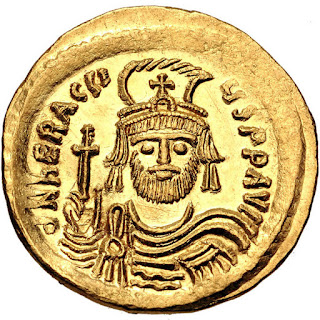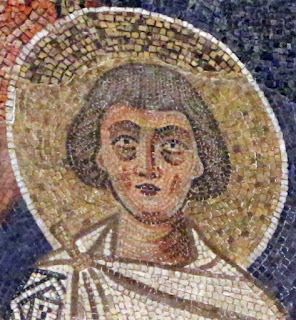HERACLIUS THE CROSS-BEARER
 |
| A Medieval French Manuscript Depiction of Emperor Heraclius Carrying the Holy Cross Back to Jerusalem |
By Bp. Joseph (Ancient Church of the West)
In the days when the Roman Empire stood upon the brink of ruin, God raised up a mighty champion of the Cross: Heraclius, Emperor of the Eastern Roman Empire of Byzantium, whose beard flowed like the prophets of old and whose heart burned with zeal for the faith. Born in Cappadocia, he rose to power in AD 610, inheriting an empire threatened on every side—by the Persians in the east and by the heresies that corroded the soul of Christendom.
The Persians, fierce and unrelenting, swept through the Holy Land in AD 614, capturing Jerusalem and bearing away the most sacred relic of the Christian faith: the True Cross, on which our Lord was crucified. In the face of this unspeakable sacrilege, Heraclius did not falter. For fourteen years, he waged war with tireless resolve, calling upon Christ the King to strengthen his hand and attempting to unite a broken Christendom, appealing to the Copts, the Syriacs, the Church of the East, and Rome to come back into communion with the beleaguered Byzantine Church. Finally, in AD 628, by divine aid, he unexpectedly and miraculously crushed the power of Persia and reclaimed the holy wood of the precious and life-giving Cross.
 |
| Heraclius and the Cross on Byzantine Coins |
 |
| The Cross Solidus Became Some of the First Pectoral Crosses Carried in Northern Europe and in the Celtic and English Patrimony |
 |
| Angels Guard Heraclius as He Battles the King of Persia |
 |
| Heraclius Depicted as a Haloed Youth, Gradually Losing Veneration and Sainthood Due to the Conflict Heraclius Had with Various Theologians and Scholars of the Day |
 |
| The Scene of Heraclius Restoring the Cross was Common Fare in Medieval Churches and Manuscripts, Depicting the Ideal Relationship Between Church and State |
 |
| A Clothed and Glorious Heraclius Restoring the Cross |
 |
| A Heraclius in a Night-Shirt Restoring the Cross |
 |
| A Martial Icon of the Restoration of the Cross |
 |
| A Renaissance Depiction Shows Heraclius Mimicking the Passion of Christ |
On March 21, AD 630, Heraclius entered Jerusalem barefoot and stripped to a loincloth, carrying the Cross upon his shoulders like another Simon of Cyrene. He bore it through the streets to the Church of the Holy Sepulchre, restoring it to its place of honor, humbling himself with bowed back and glistening sweat, declaring his love for Christ Jesus with every belabored step. The people wept with joy and sang hymns of victory, all of Christendom rejoiced at this feat, proclaiming the triumph of Christ over death and hell, and the ancient tradition of carrying a Lenten Cross was begun for men of strong health and body.
To honor the Cross and his victory, Heraclius had coins minted throughout the empire, bearing the image of the Cross of Christ - a bold proclamation of his faith and of Christ’s kingship over the nations. Some of these coins made their way as far as Britain, where they were set in golden pendants, such as the famed Wilton Cross, adorned with garnets and hung upon the necks of the faithful. Though these crosses were often worn upside down, it was not from irreverence but from tradition, with the four steps symbolizing Golgotha’s hill and the belief that the sight of the Cross would strengthen the wearers in their faith.
As Heraclius grew older, his appearance changed, reflecting the transformation within his soul. In his youth, his beard was well-groomed and neat, but as the years passed, he adopted the wild, flowing beard of the ascetic Syriac holy men—deliberately modeling himself after the desert fathers and pillar saints, such as St. Simeon the Stylite. By this sign, he proclaimed himself a monastic emperor, worthy to bear the Cross of Christ and to guard the holy places of God, so that Christendom could be revived and bear up against the threat of Persia and the internal struggle of schisms.
Though he ruled an empire, Heraclius took on the humility and penitence of a monk, for he knew that worldly power without heavenly grace is nothing but wind and ashes. His example reached even the farthest corners of the Christian world, and the flowing beards of Northern Europe - once scorned as barbaric - became symbols of Christian piety and strength amongst the Celts and Anglo-Saxons. It is possible that the profuse beards now esteemed universally in Eastern Orthodoxy were popularized once and for all by this noble emperor.
In AD 641, Heraclius departed this life, having fought the good fight and kept the faith. The Church remembers him not only as a ruler but as a Cross-bearer, one who laid down his pride and bore the burden of Christ in meekness and truth. The Third Sunday of Lent is known as the Sunday of the Holy Cross, commemorating this tale and remembering the restoration of the Holy Cross of Christ to the Church of the Holy Sepulchre in Jerusalem by this oft-forgotten and manly Christian, Heraclius the Cross-Bearer.
COLLECT
O God, who didst strengthen Thy servant Heraclius to restore the Holy Cross to its place of honor and to bear its weight in humility, grant us, we beseech Thee, that following his example, we may embrace the Cross with courage and bear it steadfastly through the trials of this life; through Jesus Christ our Lord, who liveth and reigneth with Thee and the Holy Ghost, one God, world without end. Amen.


Comments
Post a Comment